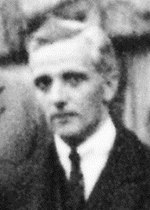Léon Brillouin
| Léon Brillouin | |
|---|---|

Léon Nicolas Brillouin (1889–1969)
|
|
| Born | August 7, 1889 Sèvres, Seine-et-Oise, France |
| Died | October 4, 1969 (aged 80) New York, USA |
| Residence | France USA |
| Citizenship | French (pre-1949) American (post-1949) |
| Fields | Physics |
| Institutions |
Sorbonne Brown University Harvard IBM Columbia University |
| Alma mater |
École Normale Supérieure Sorbonne Collège de France |
| Doctoral advisor | Paul Langevin |
| Doctoral students | Nicolas Cabrera, Ivar Stakgold |
| Known for |
Brillouin scattering Brillouin zone Brillouin function Einstein–Brillouin–Keller method WKB approximation Negentropy Brillouin–Wigner formula Brillouin doublet Brillouin flow Brillouin theorem |
| Influences |
Henri Poincaré H. A. Lorentz Albert Einstein Paul Langevin Jean Perrin Arnold Sommerfeld |
| Notes | |
|
He was the son of the physicist Marcel Brillouin.
|
|
Sorbonne
Collège de France
École Supérieure d'Électricité
Léon Nicolas Brillouin (French: [bʁilwɛ̃]; August 7, 1889 – October 4, 1969) was a French physicist. He made contributions to quantum mechanics, radio wave propagation in the atmosphere, solid state physics, and information theory.
Brillouin was born in Sèvres, near Paris, France. His father, Marcel Brillouin, grandfather, Éleuthère Mascart, and great-grandfather, Charles Briot, were physicists as well.
From 1908 to 1912, Brillouin studied physics at the École Normale Supérieure, in Paris. From 1911 he studied under Jean Perrin until he left for the Ludwig Maximilians University of Munich (LMU), in 1912. At LMU, he studied theoretical physics with Arnold Sommerfeld. Just a few months before Brillouin's arrival at LMU, Max von Laue had conducted his experiment showing X-ray diffraction in a crystal lattice. In 1913, he went back to France to study at the University of Paris and it was in this year that Niels Bohr submitted his first paper on the Bohr model of the hydrogen atom. From 1914 until 1919, during World War I, he served in the military. At the conclusion of the war, he returned to the University of Paris to continue his studies with Paul Langevin, and was awarded his Docteur ès science in 1920. Brillouin's thesis jury was composed of Langevin, Marie Curie, and Jean Perrin and his thesis topic was on the quantum theory of solids. In his thesis, he proposed an equation of state based on the atomic vibrations (phonons) that propagate through it. He also studied the propagation of monochromatic light waves and their interaction with acoustic waves, i.e., scattering of light with a frequency change, which became known as Brillouin scattering.
...
Wikipedia
